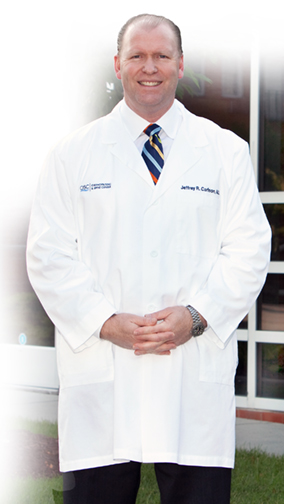Spine Surgery
Orthopaedic and Spine Center
 When Dr. Jeffrey Carlson joined Orthopaedic and Spine Center in 1999, he was the first fellowship trained spine surgeon on the Virginia Peninsula, having completed a combined Neurosurgical and Orthopaedic Fellowship in Spine Surgery at Harvard’s Brigham and Women’s Hospital in Boston.
When Dr. Jeffrey Carlson joined Orthopaedic and Spine Center in 1999, he was the first fellowship trained spine surgeon on the Virginia Peninsula, having completed a combined Neurosurgical and Orthopaedic Fellowship in Spine Surgery at Harvard’s Brigham and Women’s Hospital in Boston.
Arriving in Hampton Roads, he learned that simple discectomies were lasting an hour and a half, and disc surgeries on the neck were taking as much as two and a half hours – and both being done as inpatient procedures.
“The thinking used to be that we had to keep these patients in the hospital,” Dr. Carlson says. “But we don’t have to, and they don’t want to stay. There are risks associated with being in the hospital – bacteria, viruses and the like – and nobody really wants to be in the hospital. Patients would much rather be at home in their own environment.”
One of his first orders of business was to establish a program to teach area nurses and hospitals about micro-discectomy outpatient spine surgery, which is performed using smaller incisions, causing minor injury to soft tissue and bone, and resulting in less patient pain and a much quicker recovery. These procedures are performed in a shorter amount of time, which lessens the patient’s time under anesthesia.
Today, the majority of simple discectomy surgeries in Hampton Roads are performed as outpatient procedures, many of them in inpatient surgery centers.
Virtually all of Dr. Carlson’s cervical spine fusion cases are done as outpatient procedures as well. “We take the disc out, but then they need a fusion. The thought process has always been that if we put in screws and rods, that’s a much more painful surgery, so those patients really did have to stay in the hospital,” he says. “But we can use the same incision to get the screws and rods in that we use to get the disc out, so we’re not moving muscle and tendon and irritating the soft tissue.”
The procedure involves putting the hardware in at a different angle that grasps stronger bone. “By looking at the vertebral body, we can avoid having to do the wide dissections that have been done at the past,” he explains, “and they’re more stable.”
Surgeons have adopted these techniques because they result in less injury, less pain for the patient, a shorter recovery time, and they are familiar procedures.
The next logical progression for Dr. Carlson was to expand his practice to include outpatient lumbar fusions. He has adapted standard surgical techniques to correct patients’ neurologic issues, and provides long-term stability for any existing bone problems. It hasn’t caught on as quickly as other outpatient spine surgeries, but it’s only a matter of time.
“We’ve done 150 of these operations as outpatient procedures,” Dr. Carlson says, “and patients are now starting to demand it. They’re asking why they should undergo a four-hour surgery requiring a two-night stay in the hospital, when they can have the same procedure done in 90 minutes, and go home the same day.”
Dr. Carlson believes that for many surgeons, it’s as much a question of changing their mind set as it is in adopting new technologies that make these procedures actionable. “It’s a question of thinking globally about these things,” he says. “It’s a question of using the best method to fix our patients’ problems as quickly and efficiently as possible, reconstructing the spine, and getting them back to doing what they want to do, in as short a period of time and with as little pain as possible.”

